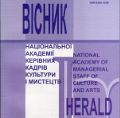СПЕЦИФІКА ПЛАСТИЧНОЇ ОБРАЗНОСТІ КОНКУРСНОГО ТАНЦЮ ПАСОДОБЛЬ
SPECIFICITY OF PLASTIC IMAGERY OF COMPETITIVE DANCE PASODOBLE
Author(s): Roman GritsenyukSubject(s): Theatre, Dance, Performing Arts, Cultural history
Published by: Національна академія керівних кадрів культури і мистецтв
Keywords: Pasodoble; competitive dance; plastic; artistic imagery; theatricalisation;
Summary/Abstract: The purpose of the article is to reveal the specificity of the plastic imagery of the Pasodoble competition dance. Research methodology. The historical method was applied, which contributed to the study of the origin and development of Pasodoble; the typological method thanks to which the peculiarities of its formation as a competitive ballroom dance were revealed; the method of artistic-stylistic and art-historical analysis, with the aim of identifying characteristic stylistic features, features of performance technique and specifics of Pasodoble's plastic imagery; method of theoretical analysis and generalisation. Scientific novelty. The plastic imagery of the Pasodoble competitive ballroom dance is studied; the technique of its implementation is characterised; the history of the origin of the dance is considered; The peculiarities of the theatricalisation of Pasodoble's choreography as one of the ten dances of the international competition programme have been revealed. Conclusions. The dramatic Latin American dance, which originated in Spain, has become one of the most popular ballroom dances in the world over the last hundred years. The specific combination of dance elements and figures in the composition by French dance teachers in the 1920s create a unique Pasodoble choreography. In the 1940s, it was codified as one of the dances in the Latin American International Style programme. Pasodoble is characterised by strong, bold movements, and the use of dramatic poses in the process of telling the story of the bullfight. Due to its theatricality and unique music, the Pasodoble is commonly performed at ballroom dance competitions and used in stage ballroom choreography. Pasadoble dance and music are steeped in ritual tradition, with a high sense of drama and power. The specific attire of the dancers, the feel and atmosphere of the dance refer to Flamenco – these dances have a strong connection and symbolic origin in Spanish history and culture. The aesthetic expressiveness of Pasodoble is created by plasticity, a musical-plastic image, which embodies the combination of the inner potential of the dancing couple and the mastery of their bodily expressiveness. Specific theatricalisation by means of choreographic expressiveness is manifested in the Pasodoble competition ballroom dance in many ways. The creation of choreography oriented and theatrical interpretation is connected with solving a number of artistic tasks. The complex of expressive means used by dancers helps to clearly outline the meaningful line of the dance. The imagery of the Pasodoble competition ballroom dance choreography is characterised by its own poetic reflection of the bullfight, taking into account the current codification of steps and figures of the Latin American programme of the international style. The plastic image represents socio-cultural aspects, current social symbols, and meanings in the dance.
Journal: Вісник Національної академії керівних кадрів культури і мистецтв
- Issue Year: 2023
- Issue No: 3
- Page Range: 166-171
- Page Count: 6
- Language: Ukrainian

